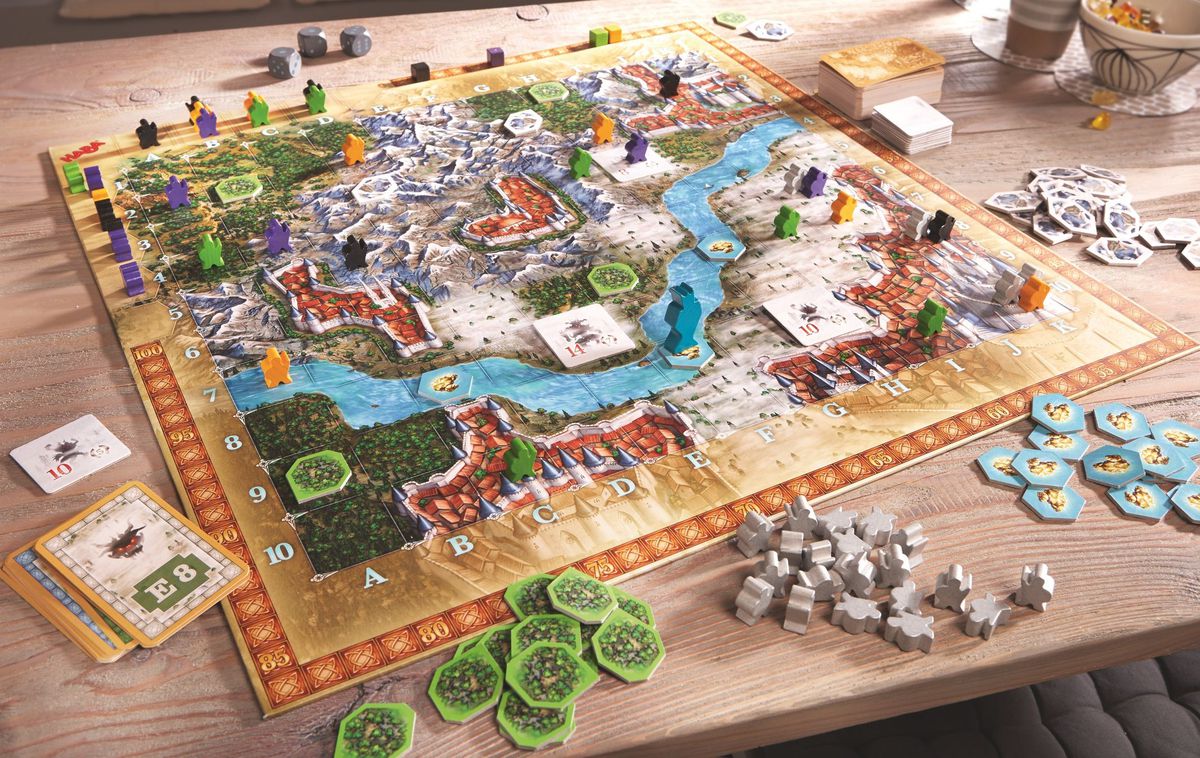Loot the Map to Battle Monsters in Adventure Land

Legendary board game designer pair Michael Kiesling and Wolfgang Kramer urge players to become adventurers on the hunt for victory points in this grid movement puzzle.
Gameplay
Adventure Land is a 2 to 4 player game in which players take the role of a band of adventurers competing to gain the most victory points.
Play begins with players setting their armies of colored meeples on the northern and western sides of the gridded game board. Each turn, players will turn over two cards revealing a sector on the grid to place the specified items: followers, swords, herbs, gold, or fog monsters. Each of these items differ in what they offer players upon collection and how they can be used.
After cards are drawn, players may move one of their meeple adventurers two spaces east or south, or two adventurers one space. These meeples may never backtrack to move back toward the north or west from where they came. However, players can move their meeples as far west or south as they wish until they pick up an item or encounter a fog monster. If a row or column has two items the player is able to collect, each pick up of the item is part of one move.
Items such as swords, gold, and herbs help players take on the fog monsters that populate the board. Swords and herbs will have differing totals on them, which will help when players face off against monsters. Each fog monster will have a life value (which must be rolled to defeat it) and a victory point value. Players will roll dice and use collected items as necessary to complete the objective. For example, if a player rolls a 7 and the fog monster requires a value of 10 to defeat, a player may play an herb worth two points and a sword worth one point so that their total is now 10. Followers and gold, which are also collected during the course of the game, are worth one point each toward battling a monster.
Victory points are also collected in other ways, depending on which of the game’s three adventures players choose. Adventures act as scenarios, outlining the objectives and point-scoring goals in the game. One focuses heavily on gathering followers and defeating monsters to earn points, another asks players to hoard items for points, and one adds an area control element by asking players to populate the walled cities on the board with the most meeples (which includes followers).
Once all the followers or sword tokens have been placed, players finish the round and then calculate points as determined by the conditions outlined in the selected adventure. The player with the most victory points wins.

Photo provided by HABA
Review
Despite appearances, Adventure Land offers itself not as a simplified version of a dungeon crawler but rather as an abstract puzzle. Kramer and Kiesling are known for how they transform simple rule sets into games where optimizing movements, actions, and item management is key. Adventure Land is no different, though it keeps these puzzles fairly family weight.
However, children and adults who struggle with spatial puzzles will find it hard to navigate the board no matter the selected adventure. It is easy to forget that players may only move east and south, and if a player rushes out all their adventurers from the starting point, they may miss valuable items that will help with end game scoring. Planning movements is key to success.
Thankfully the game does not suffer from analysis paralysis despite these limitations. With the board always being populated — and being a well-sized board with many sections to explore — players will always have access to items that will either score points at the end of the game or give them the edge in meeting the adventurer’s criteria to maximize points (for example, gathering followers to help populate a city).
For a game that comes across as simple in its presentation, it offers some chess-like complexity with the right company. And though the board is big enough to accommodate four players competing for items, it is common for strategies to overlap causing fun player interactions, especially as more adventurers populate all corners of the board. In two player games, it’s often the opposite effect where fewer adventurers are out on the board by the time the follower or sword supplies are depleted. The variance in player count adding unpredictability to the game’s flow, coupled with the different goals of each adventure, keeps the game fresh. If players worry that they may overplay the original scenarios, the game offers the King & Princess expansion that offers new items and new adventures that can ratchet up the difficulty as needed (though the trope of saving a Princess seems a bit outdated).
Adventure Land is a solid addition to HABA’s Game Night line. It was initially overshadowed upon its release thanks to another Game Night line hit: Rüdiger Dorn’s Karuba. That does not make Adventure Land inferior, but rather solidifies the place of HABA’s Game Night line as something that gamers of all stripes can enjoy with delightful secrets. It’s time to recognize that HABA does more than just children’s games.
Pros: Easy to set up and play, Variable end goals and objectives, Fun movement puzzle
Cons: Spatial puzzle elements, Limiting movement rule set









